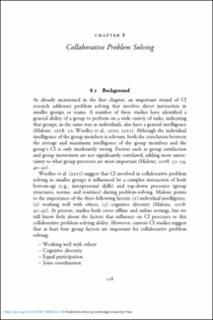| dc.contributor.author | Baltzersen, Rolf K | |
| dc.date.accessioned | 2022-09-25T23:00:13Z | |
| dc.date.available | 2022-09-25T23:00:13Z | |
| dc.date.issued | 2022 | |
| dc.identifier.uri | https://hdl.handle.net/11250/3021114 | |
| dc.description | Chapter 8 in Cultural-historical perspectives on collective intelligence
In the era of digital communication, collective problem solving is increasingly important. Large groups can now resolve issues together in completely different ways, which has transformed the arts, sciences, business, education, technology, and medicine. Collective intelligence is something we share with animals and is different from machine learning and artificial intelligence. To design and utilize human collective intelligence, we must understand how its problem-solving mechanisms work. From democracy in ancient Athens, through the invention of the printing press, to COVID-19, this book analyzes how humans developed the ability to find solutions together. This wide-ranging, thought-provoking book is a game-changer for those working strategically with collective problem solving within organizations and using a variety of innovative methods. It sheds light on how humans work effectively alongside machines to confront challenges that are more urgent than what humanity has faced before. This title is also available as Open Access on Cambridge Core. | en_US |
| dc.description.abstract | Chapter 8 proposes collaborative problem solving as one of three distinct types of CI. Collaborative problem solving covers a wide range of disciplines and contexts, but this chapter primarily draws on studies that have explicitly used CI as a scholarly concept. The most important finding is the identification of a general group performance ability on a wide variety of tasks. This group performance is analyzed in relation to four dimensions that promote successful collaborative problem solving. First, “working well with others” is not only analyzed as an individual ability, but as a quality that emerges through the qualities of a symmetrical collaborative relationship. Second, “cognitive diversity” describes diverse repertoires in groups, also including multidisciplinary and multicultural diversity. Third, “equal participation” emphasizes that everyone in the group should be allowed to bring in their perspective, and group discussions need to be open-minded. Fourth, “joint coordination” is important in setting goals together, dividing tasks and choosing relevant problem solving strategies. Solver experiences from online innovation teams exemplify how this type of CI can move forward in a highly relevant authentic online setting. | en_US |
| dc.language.iso | eng | en_US |
| dc.publisher | Cambridge University Press | en_US |
| dc.rights | Attribution-NonCommercial-NoDerivatives 4.0 Internasjonal | * |
| dc.rights.uri | http://creativecommons.org/licenses/by-nc-nd/4.0/deed.no | * |
| dc.subject | General group intelligence factor | en_US |
| dc.subject | Working well with others | en_US |
| dc.subject | Cognitive diversity | en_US |
| dc.subject | Multidisciplinary diversity | en_US |
| dc.subject | Multicultural diversity | en_US |
| dc.subject | Equal participation | en_US |
| dc.subject | Joint coordination | en_US |
| dc.subject | Online innovation teams | en_US |
| dc.subject | Collective intelligence | en_US |
| dc.title | Collaborative Problem Solving | en_US |
| dc.type | Chapter | en_US |
| dc.source.pagenumber | pp 238-253 | en_US |
| dc.identifier.doi | 10.1017/9781108981361.008 | |

